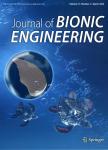Growth of TiO2 Nanotube on Titanium Substrate to Enhance its Biotribological Performance and Biocorrosion Resistance
作者机构:Institute of Orthopaedic&Musculoskeletal ScienceDivision of Surgery&Interventional ScienceUniversity College LondonRoyal National Orthopaedic HospitalStanmoreHA14LPUnited Kingdom School of Mechatronical EngineeringBeijing Institute of TechnologyBeijing 100081China State Key Laboratory of Solid L ubricationLanzhou Institute of Chemical PhysicsChinese Academy of SciencesLanzhou 730000China
出 版 物:《Journal of Bionic Engineering》 (仿生工程学报(英文版))
年 卷 期:2019年第16卷第6期
页 面:1039-1051页
核心收录:
学科分类:0710[理学-生物学] 0831[工学-生物医学工程(可授工学、理学、医学学位)] 08[工学] 080502[工学-材料学] 0805[工学-材料科学与工程(可授工学、理学学位)] 0836[工学-生物工程] 0702[理学-物理学]
基 金:This project is financially supported by the EU via the H2020-MSCA-RISE-2016 program(Grant no:734156) Royal Society via the International Exchange Program(Grant no:IE 161349) Key Research Project from the National Key Research and Development Program of China(2016YFC1100401) National Natural Science Foundation of China(51705507) Young Elite Scientists Sponsorship Program by CAST(2017QNRC001)
主 题:TiO2 nanotubes tribology titanium implant surface modification biomaterials
摘 要:TiO2 nanotubes(NTs)have a great potential in improving the osetointegration of titanium(Ti)-based *** efforts have been made to evaluate the biological performance of the TiO2 nanotube in regulating protein adsorption and cells *** often used in orthopaedic applications,although biotribological performance and biocorrosion are important issues in these applications,few researches have been reported on the biotribological perfonnance of NT *** paper reports the preparation of a structure-optimised TiO2 NT(SO-NT)material via a multi-step oxidation strategy,as well as its biotribological and biocorrosion *** this procedure,an interfacial bonding layer of approximately 120 nm=150 nm was first formed on the titanium substrate,which was then joined to the NT *** mechanical testing with respect to impact,bending,and biotribological perfbnnance have demonstrated the resultant SO-NT layer possess improved mechanical stability compared to conventional *** uniform hyperfine interfacial bonding layer with nano-sized grains exhibited a strong bonding to NT layer and Ti *** was observed that the layer not only effectively dissipates external impacts and shear stress but also acts as a good corrosion resistance barrier to prevent the Ti substrate from *** models were proposed to analyze and predict the shear performance and corrosion-resistance mechanisms of the resultant *** obtained results demonstrated that the SO-NT material has great potential in orthopaedic applications.



